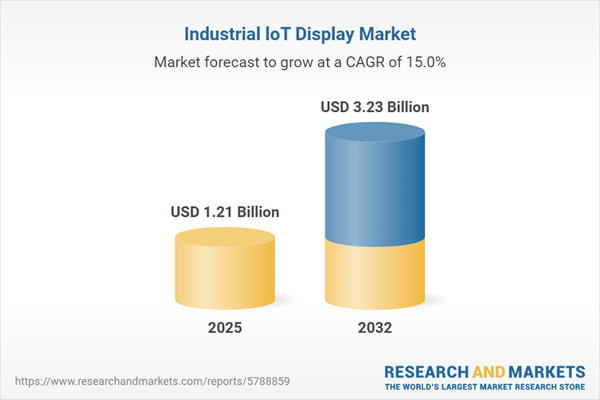Speak directly to the analyst to clarify any post sales queries you may have.
The Industrial IoT Display Market is evolving rapidly as organizations seek operational efficiency and enhanced data visibility across connected industrial environments. Senior decision-makers are prioritizing advanced display solutions that serve as vital interfaces between machines and people, enabling smarter, data-driven operations at every enterprise level.
Market Snapshot: Industrial IoT Display Growth and Opportunities
The Industrial IoT Display Market grew from USD 1.05 billion in 2024 to USD 1.21 billion in 2025. It is expected to continue growing at a CAGR of 14.99%, reaching USD 3.23 billion by 2032.
Scope & Segmentation: Key Drivers and Diversity Across Segments
This market research provides a deep dive into the evolving landscape of industrial IoT display solutions, examining both established and emerging application scenarios across global geographies. Key segmentation areas and drivers include:
- End User Industry: Automotive (commercial and passenger vehicles), Energy and Utilities (power generation, renewables, water utilities), Healthcare (diagnostics, hospitals, pharmaceuticals), Manufacturing (including automotive, electronics, food and beverage), Oil and Gas (downstream, midstream, upstream).
- Application: Asset tracking, energy management, predictive maintenance (thermal imaging, vibration monitoring), process automation (continuous and discrete manufacturing), quality control.
- Display Type: HMI panels, rugged tablets, smart glasses, vision systems, wearable displays.
- Connectivity Technology: Bluetooth, cellular, Ethernet, LoRaWAN, Wi-Fi.
- Screen Size: Greater than 10 inch, seven to ten inch, less than seven inch.
- Geographic Coverage: Americas (North America, Latin America), EMEA (Europe, Middle East, Africa), Asia-Pacific (including China, India, Japan, Australia, South Korea, Indonesia, Thailand, Malaysia, Singapore, Taiwan).
- Company Coverage: Siemens Aktiengesellschaft, Schneider Electric SE, Rockwell Automation, Inc., Mitsubishi Electric Corporation, Omron Corporation, Advantech Co., Ltd., Beckhoff Automation GmbH & Co. KG, Kontron AG, Axiomtek Co., Ltd., Winmate Inc.
Key Takeaways for Decision-Makers
- Industrial IoT displays are becoming instrumental in bridging machine data with actionable insights, supporting real-time monitoring and minimizing operational downtime across sectors.
- The convergence of advanced connectivity standards and immersive display technologies is driving demand for resilient, user-centric interfaces, particularly in dynamic and regulated environments.
- Segmentation insights show sector-specific demands, such as rugged, vibration-resistant panels for automotive and explosion-proof enclosures for oil and gas, emphasizing the need for tailored solutions.
- Strategies emphasizing modular design, supply chain transparency, and regional assembly are gaining traction as organizations respond to shifting regulatory and economic conditions.
- Collaboration between display manufacturers, semiconductor firms, and connectivity providers accelerates innovation, facilitating integration with edge computing and predictive analytics platforms.
Tariff Impact: Navigating Regulatory Shifts
Recent United States tariff adjustments have influenced component sourcing and pricing dynamics throughout the industrial electronics supply chain. These developments drive supply chain diversification, increased investment in localized assembly, and adoption of modular display systems to better manage project costs and regulatory uncertainties. Companies are leveraging transparency tools and regional supplier partnerships to maintain resilience in the face of ongoing policy changes.
Research Methodology & Data Sources
This analysis uses structured interviews with industry stakeholders and comprehensive secondary research—including review of whitepapers, regulatory documents, and vendor specifications. Segmentation analysis and data triangulation support robust findings, while validation tests and expert reviews address potential bias, ensuring credible outcomes.
Why This Report Matters for Industrial IoT Display Market Stakeholders
- Provides in-depth, actionable insights specifically tailored to the unique drivers, challenges, and opportunities in each major segment and global region.
- Enables benchmarking of strategic priorities, from integrating new display technologies to managing supply chain and compliance risks amid regulatory changes.
- Supports informed decision-making by delivering a holistic market overview along with targeted recommendations for optimizing technology investments and future-proofing industrial operations.
Conclusion
The Industrial IoT Display Market is undergoing a transformative period as technology, regulation, and operational demands intersect. This report delivers clear, strategic guidance to help industry leaders optimize adoption, manage emerging risks, and drive long-term competitive advantage.
Additional Product Information:
- Purchase of this report includes 1 year online access with quarterly updates.
- This report can be updated on request. Please contact our Customer Experience team using the Ask a Question widget on our website.
Table of Contents
3. Executive Summary
4. Market Overview
7. Cumulative Impact of Artificial Intelligence 2025
Companies Mentioned
The companies profiled in this Industrial loT Display market report include:- Siemens Aktiengesellschaft
- Schneider Electric SE
- Rockwell Automation, Inc.
- Mitsubishi Electric Corporation
- Omron Corporation
- Advantech Co., Ltd.
- Beckhoff Automation GmbH & Co. KG
- Kontron AG
- Axiomtek Co., Ltd.
- Winmate Inc.
Table Information
| Report Attribute | Details |
|---|---|
| No. of Pages | 186 |
| Published | October 2025 |
| Forecast Period | 2025 - 2032 |
| Estimated Market Value ( USD | $ 1.21 Billion |
| Forecasted Market Value ( USD | $ 3.23 Billion |
| Compound Annual Growth Rate | 14.9% |
| Regions Covered | Global |
| No. of Companies Mentioned | 11 |









